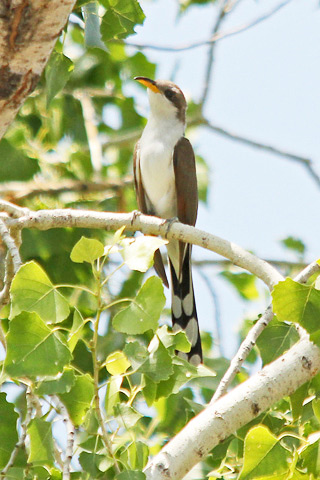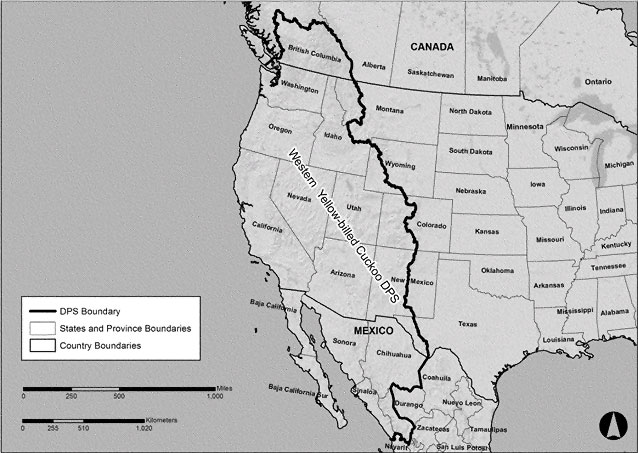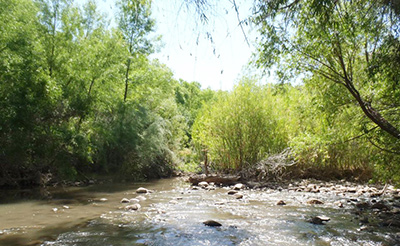Secretive, except for its distinctive guttural call, the western yellow-billed cuckoo is an increasingly rare bird dependent on large patches of native streamside forest in the American West.
Taxonomy
The yellow-billed cuckoo is a long-distance Neotropical migrant bird in the cuckoo family (Cuculidae). The western population of the species (Coccyzus americanus occidentalis) breeds along river systems west of the Rocky Mountains, which generally separate this population from its counterpart, the eastern yellow-billed cuckoo (Coccyzus americanus americanus). While the formal distinction between the two population groups has been debated since the late 1980s, the U.S. Fish and Wildlife Service identifies yellow-billed cuckoos west of the Continental Divide as a Distinct Population Segment for conservation purposes.
Description

Photo Courtesy of Gary Botello
The yellow-billed cuckoo is a slim, long-tailed bird about 30 cm (12 inches) in length, sometimes confused with a dove. It weighs about 60 g (2 ounces). Its broad curved bill is yellow at the base of the lower mandible and black on top. The grayish-brown color of its head and back contrasts with its white underparts. The long tail is grayish brown above and strikingly marked with 6 white spots against a black background below. This distinctive tail pattern shows both during flight and when perched. Another key to identifying this bird is the large reddish wing patch visible when it flies. Males, females and juveniles share the same plumage, although the undertail pattern of oval spots is more distinct in males than in females or juveniles. Its zygodactyl feet (2 toes forward and 2 toes backward) are unlike the 3 forward and 1 backward pointing toe arrangement of most songbirds, and help the cuckoo grasp and move around on branches more easily.
Secretive and often hunkered down motionlessly behind dense foliage, the yellow-billed cuckoo is not easy to detect unless you hear its loud “Kowlp” call (“ka, ka, ka, ka, ka, kow, kow, kow, kowlp, kowlp”). Researchers have described the call as, “guttural” and, “wooden-sounding.” Additional calls complete its repertoire of vocalizations: the “Knocker” call is a rapid series of harsh notes (“kow-kow-kow-kow-kow”), which both members of a pair may use to contact each other in close vicinity; the whining “Mew” call is given as part of the cuckoo’s distraction display when threatened at the nest.
Distribution

U.S. Fish and Wildlife Service. Federal Register, 2013.
Historically, breeding western yellow-billed cuckoos occurred west of the Continental Divide, from British Columbia south into northern Mexico. They no longer occur in much of their historic range, but breed instead rarely and locally along rivers in Arizona, California, and New Mexico. They migrate to wintering grounds in South America.
Habitat Associations

Photo Coutresy of Christopher Calvo
A riparian species, the western yellow-billed cuckoo breeds in low- to moderate-elevation native forests lining the rivers and streams of the western United States. Cottonwood-willow forests (Populus spp. - Salix spp.) are most often used, although other riparian tree species can be important components of breeding habitat as well, such as alder (Alnus spp.), box elder (Acer negundo), mesquite (Prosopis spp.), Arizona walnut (Juglans major), Arizona sycamore (Platanus wrightii), oak (Quercus spp.), netleaf hackberry (Celtis reticulata), velvet ash (Fraxinus velutina), Mexican elderberry (Sambuccus mexicanus), seepwillow (Baccharis glutinosa), and occasionally, tamarisk (Tamarix spp.).
Western yellow-billed cuckoos require relatively large (>20 hectares), contiguous patches of multilayered riparian habitat for nesting. The multilayered canopy provides shade and traps moisture to create the relatively cooler and more humid streamside conditions which are believed to be important for nesting success. They are also known to nest in early to mid-successional native riparian habitat.
Migration and wintering habitat needs are not well known, although they appear to include a relatively wide variety of conditions. Migrating yellow-billed cuckoos have been found in coastal scrub, second-growth forests and woodlands, hedgerows, forest edges, and in smaller riparian patches than those used for breeding. Wintering yellow-billed cuckoos generally use woody lowland vegetation near fresh water.
Feeding Habits
Perching motionlessly on a tree branch, the diurnal yellowbilled cuckoo scans the surrounding foliage with a slow tilting of the head to find caterpillars, cicadas, katydids, and other insects to eat. It may also hop or run along the branch to capture its prey, or launch into short flights to snag flying insects, like a flycatcher. Frogs and lizards comprise some of its diet as well, captured either in trees or pursued on the ground and subdued by pecking. Fruit and seeds are also eaten, more frequently on wintering grounds.
Reproductive Biology
Western yellow-billed cuckoos arrive on their breeding grounds later than most other Neotropical migrants, typically in early to mid-June. They pair up on the breeding grounds but do not appear to vigorously defend a nesting territory. Instead, they are known to move around during the breeding season, often timing the onset of breeding to coincide with an abundance of large insects.
The horizontal branch of a willow tree is a favored platform for the western yellow-billed cuckoo nest. Both the female and the male build the nest, creating a loosely-built, flat, saucer-shaped stick construction (outside diameter averages 20.9 cm) lined with bark and leaves, with a shallow cup (2–4 cm deep). The construction is so thin that eggs may be seen through the bottom of the nest from below. The nest is typically positioned 1 to 6 m above the ground and below a dense patch of canopy.
Once breeding begins, it proceeds quickly—the entire cycle may last only 17 days from egg laying to fledging. One to 5 smooth, unmarked eggs (average of 2 to 3) are laid, appearing pale bluish green at first and later fading to light greenish yellow. Both the male and female incubate the eggs for 9 to 11 days until hatching. A few days after hatching, bursting feather sheaths enable nestlings to become fully feathered within a period of hours. Nestlings begin to fledge at 6 to 9 days old. After fledging, the young are dependent upon parents for another 3 weeks. By late August, most western yellow-billed cuckoos have begun their southward migration for the winter.
Jays (family Corvidae), snakes, and small mammals prey upon the eggs and young during this vulnerable nesting period. When the nest is threatened, adult cuckoos may try to distract the invader away from the nest with a special display. In dense canopy, Hughes (1999) describes this distraction display as a “ slow, downward, fluttering drop through nesting tree with wings held high over back and opened so that bright rufous of primaries flashed; tail half fanned.” It utters a combination of the “Mew” call and “Knocker” call throughout the display. For nests in more open canopy, this distraction display is a “slow, erratic, wavering flight about 1 m above ground, with tail flashing white spots and wings held open to display rufous patches” (Hughes 1999).
Management and Conservation
Western yellow-billed cuckoo numbers have plummeted over the past several decades, with a corresponding contraction of their breeding range. Eastern yellow-billed cuckoo numbers have also declined, but not nearly as drastically. Western yellow-billed cuckoos are now gone from British Columbia and the Pacific Northwest, and most of the remaining birds are found in isolated patches of riparian habitat along rivers in Arizona, California, and New Mexico. Surveys in California during 1986–1987 found only 30–33 pairs remaining in the state, compared with an estimated 15,000 pairs in the late nineteenth century. Data from Arizona, where the cuckoo was once a common nester, show comparable declines, suggesting that less than 200 pairs remained in the state by 1986.
As a result of these declines, the U.S. Fish and Wildlife Service approved a petition in 2001 to list the western yellow-billed cuckoo as threatened under the Endangered Species Act. The ruling identified the declining birds as a Distinct Population Segment, rather than a subspecies, although it applied to the entire western population of cuckoos. Precluded by higher priority species, the bird remained a candidate species for several years afterwards. Effective November 3, 2014, the U.S. Fish and Wildlife Service listed the western distinct population segment of the yellow-billed cukoo as threatened under the Endangered Species Act. Most western states in which it occurs list it at various levels of conservation concern.
The loss and degradation of native riparian habitat throughout the western yellow-billed cuckoo’s range have played a major role in the bird’s decline. Residential development, ground-water pumping, agriculture, flood control, and nonnative plant invasions all negatively alter the composition of the streamside forests these birds depend on. However, several management plans are already in place to protect and restore riparian habitat in the southwestern United States that could benefit the western yellow-billed cuckoo. For example, the Lower Colorado River Multi-Species Conservation Program calls for restoring more than 1,618 ha (4,000 acres) of habitat for the bird. Cuckoos have increasingly occupied some of these restored areas.
Pesticide use may also be harming western yellow-billed cuckoo populations. Reproduction problems caused by eggshell thinning have been documented in the western yellow-billed cuckoo, causing concern about pesticide loads for the species. Pesticides in caterpillars, or in frogs and other prey using polluted runoff from agricultural fields, may be sources of contamination.
Climate change has the potential to be an additional stressor to the western yellow-billed cuckoo. The warmer temperatures already occurring in the southwestern United States may alter the plant species composition of riparian forests over time. An altered climate may also disrupt food availability for the western yellow-billed cuckoo if the timing of peak insect emergence changes in relation to when the cuckoos arrive on their breeding grounds to feed on this critical food source.
References
Corman, T. E. 2005. “Yellow-billed Cuckoo Coccyzus americanus”. Pages 202-203 in The Arizona Breeding Bird Atlas, edited by Troy Corman and Catherine Wise-Gervais. University of New Mexico Press, Albuquerque.
Halterman, Murrelet . March 2012 [Draft]. “Western Yellow- Billed Cuckoo (Coccyzus americanus occidentalis)” in Section 5, Birds, Baseline Biology Report. Desert Renewable Energy Conservation Plan. Accessed on October 23, 2013 from http://www.drecp.org/documents/ docs/baseline_biology_report/05_Baseline_Biology_ Report_Section_5.pdf
Hughes, Janice M. 1999. Yellow-billed Cuckoo (Coccyzus americanus), The Birds of North America Online (A. Poole, Ed.). Ithaca: Cornell Lab of Ornithology. Retrieved from the Birds of North America Online: http://bna.birds. cornell.edu/bna/species/418
Johnson, Matthew J. 2009. Understanding the habitat needs of the declining western yellow-billed cuckoo: U.S. Geological Survey Fact Sheet 2009-3091.
NatureServe. 2013. NatureServe Explorer: An online encyclopedia of life [web application]. Version 7.1. NatureServe, Arlington, Virginia. Available http://www. natureserve.org/explorer. (Accessed: October 23, 2013).
U.S. Fish and Wildlife Service. 2014. Endangered and Threatened Wildlife and Plants; Determination of Threatened Status for the Western Distinct Population Segment of the Yellow-billed Cuckoo (Coccyzus americanus); Final Rule. Federal Register Vol. 79. No. 192. Oct 3, 2014.
Prepared by Sonya Daw, Southern Colorado Plateau Network I&M Program, November 2014.
Last updated: February 4, 2015
